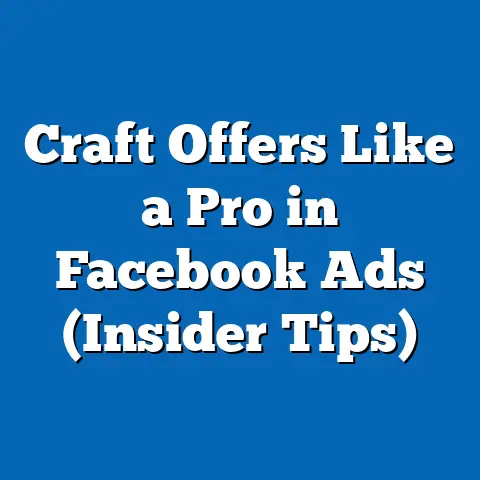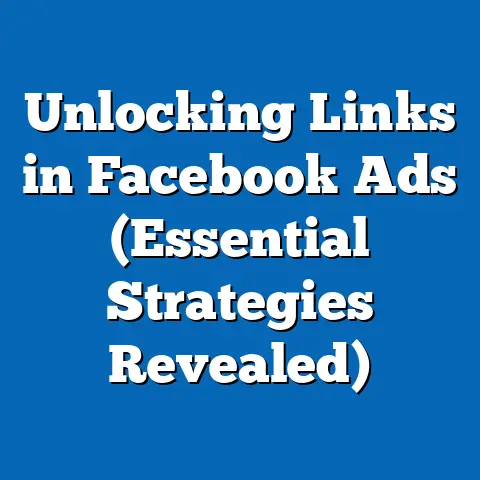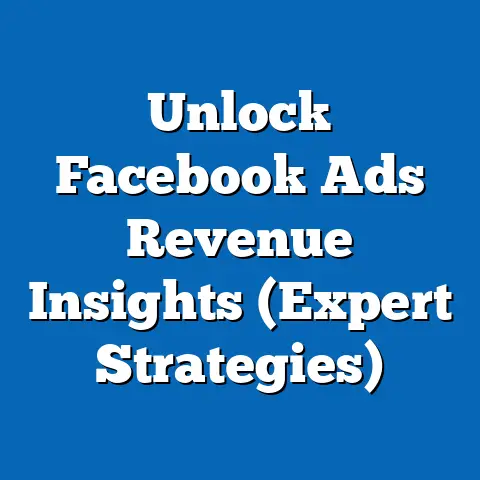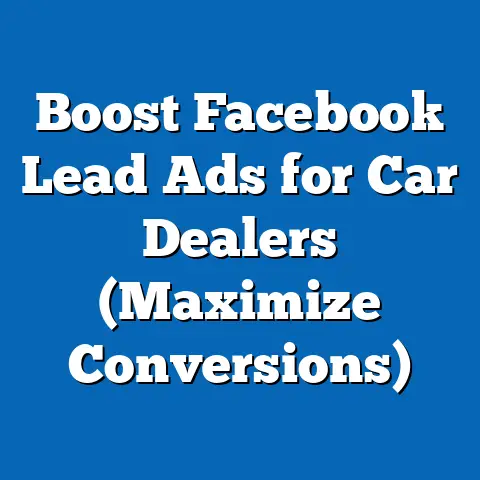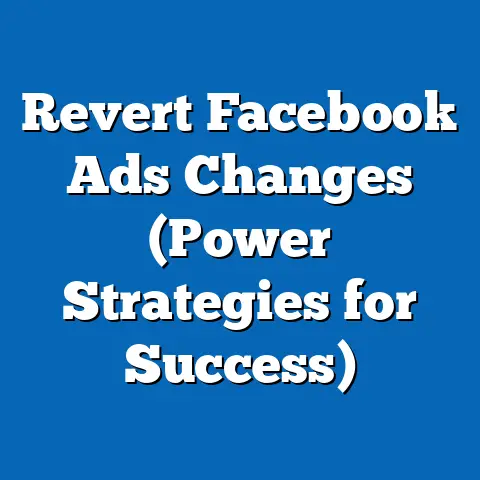Boost Facebook Ad Score (Game-Changing Strategies)
Imagine your Facebook ad campaign as a carefully tended garden. You wouldn’t just scatter seeds and hope for the best, would you? You’d prepare the soil, choose the right plants for the environment, water and fertilize them regularly, and protect them from pests. Similarly, a successful Facebook ad campaign requires a strategic approach, constant care, and a keen understanding of the platform’s nuances. One of the most critical aspects of nurturing your “ad garden” is understanding and optimizing your Facebook Ad Score.
I’ve spent years navigating the ever-changing landscape of Facebook advertising, and I can tell you firsthand that mastering the Ad Score is a game-changer. It’s not just about creating pretty ads; it’s about creating ads that resonate with your audience, deliver value, and ultimately, drive results. This guide will provide you with the knowledge and strategies you need to cultivate a thriving Facebook ad campaign by boosting your Ad Score.
1. Understanding Facebook Ad Score
The Facebook Ad Score, though not directly visible anymore, still significantly impacts your ad performance. While Facebook phased out the numerical score displayed in the Ads Manager, the underlying factors that contributed to it remain crucial. Think of it as the invisible hand guiding your ad’s success. It’s essentially a measure of how well your ad resonates with your target audience, and it’s influenced by several key components:
- Ad Relevance Diagnostics: This is Facebook’s assessment of how relevant your ad is to the people you’re targeting. It’s based on expected engagement, quality ranking, and conversion ranking.
- Engagement Rate: How often are people interacting with your ad (likes, comments, shares, clicks)? A high engagement rate signals to Facebook that your ad is interesting and valuable.
- Conversion Rate: Are people taking the desired action after seeing your ad (e.g., making a purchase, signing up for a newsletter)? A high conversion rate demonstrates that your ad is not only relevant but also effective.
- Landing Page Experience: This factor considers the quality and relevance of the landing page your ad directs users to. A seamless, user-friendly landing page that delivers on the ad’s promise is crucial.
Why is Ad Score Important?
A high Ad Score translates to several benefits:
- Lower Costs: Facebook rewards relevant ads with lower costs per click (CPC) and cost per acquisition (CPA). You’re essentially getting more bang for your buck.
- Improved Ad Delivery: Facebook prioritizes ads with high Ad Scores, giving them greater visibility and reach within your target audience.
- Increased Conversions: Relevant ads are more likely to resonate with your audience, leading to higher conversion rates and ultimately, more sales or leads.
How to Interpret the “Invisible” Ad Score
Even though you can’t see a numerical score, you can still gauge your ad’s performance by monitoring the individual components within the Ads Manager. Pay close attention to:
- Relevance Diagnostics: These provide insights into how your ad is performing in terms of quality, engagement, and conversion. Aim for “Above Average” in all categories.
- Click-Through Rate (CTR): A high CTR indicates that your ad is capturing attention and piquing interest.
- Conversion Rate: Track your conversion rate closely to ensure your ad is driving the desired action.
- Cost Per Result: Monitor your cost per result (e.g., cost per purchase, cost per lead) to assess the efficiency of your ad spend.
Takeaway: While the numerical Ad Score is gone, the underlying principles remain. Focus on creating relevant, engaging, and high-converting ads to reap the benefits of a strong “invisible” Ad Score.
2. The Importance of Target Audience
Imagine trying to sell snow shovels in Miami. You might have the best snow shovels in the world, but you’re targeting the wrong audience. The same principle applies to Facebook advertising. You can have the most beautifully designed ad with compelling copy, but if you’re showing it to the wrong people, it’s going to fall flat.
Why is Audience Targeting Crucial?
- Relevance: When you target the right audience, your ads become more relevant, leading to higher engagement and conversion rates.
- Efficiency: Precise targeting ensures that your ad spend is focused on people who are most likely to be interested in your product or service.
- Improved Ad Score: Facebook rewards ads that are relevant to their target audience, resulting in a higher Ad Score and lower costs.
Tools and Strategies for Audience Research:
- Facebook Audience Insights (Now Part of Meta Business Suite): While the standalone Audience Insights tool is no longer available, similar data and insights are integrated within the Meta Business Suite. This allows you to explore demographics, interests, behaviors, and connections of people on Facebook and Instagram.
- Facebook Pixel Data: The Pixel collects valuable data about your website visitors, allowing you to create custom audiences based on their actions (e.g., viewed specific pages, added items to cart, made a purchase).
- Lookalike Audiences: Leverage your existing customer data to create lookalike audiences, which are people who share similar characteristics and interests with your best customers.
- Competitor Analysis: Analyze your competitors’ Facebook pages and ads to identify potential target audiences and strategies.
Examples of Successful Audience Targeting:
- Example 1: A local bakery could target people within a 5-mile radius who are interested in baking, desserts, and local businesses.
- Example 2: An online fitness coach could target people who are interested in fitness, weight loss, healthy eating, and follow relevant fitness influencers.
- Example 3: An e-commerce store selling eco-friendly products could target people who are interested in sustainability, environmentalism, and ethical shopping.
Takeaway: Investing time and effort in understanding your target audience is essential for creating effective Facebook ad campaigns. Utilize the tools and strategies available to identify and reach the right people with your message.
3. Crafting Compelling Ad Content
Once you’ve identified your target audience, the next step is to create ad content that captures their attention and compels them to take action. Think of your ad as a miniature billboard vying for attention in a crowded digital space.
Elements of High-Performing Ad Copy:
- Headlines: Your headline is the first thing people see, so make it count. Use strong verbs, ask a question, or highlight a key benefit. Keep it concise and attention-grabbing.
- Descriptions: Your description provides more detail about your offer. Focus on the value proposition and how it solves a problem for your target audience.
- Calls to Action (CTAs): Your CTA tells people what you want them to do next. Use clear and concise language, such as “Shop Now,” “Learn More,” “Sign Up,” or “Get a Quote.”
The Importance of Visuals:
- Images vs. Videos: Both images and videos can be effective, but the best format depends on your product or service and your target audience. Videos tend to be more engaging, but high-quality images can also capture attention.
- Choosing the Right Format: Use high-resolution images that are visually appealing and relevant to your message. For videos, keep them short and engaging, and optimize them for mobile viewing.
- Visual Consistency: Ensure your visuals are consistent with your brand’s overall aesthetic.
Tips on Storytelling in Ads:
- Connect with Emotions: Tap into your audience’s emotions by telling a story that resonates with their values and aspirations.
- Highlight the Problem and Solution: Clearly identify the problem your product or service solves and how it can improve your audience’s lives.
- Use Customer Testimonials: Share stories from satisfied customers to build trust and credibility.
Creating Emotional Connections:
- Understand Your Audience’s Needs: Identify their pain points, desires, and motivations.
- Use Empathetic Language: Show that you understand their struggles and offer a solution that addresses their needs.
- Create a Sense of Community: Foster a sense of belonging by highlighting shared values and experiences.
Takeaway: Compelling ad content is essential for capturing attention, building interest, and driving conversions. Craft your ad copy and visuals with your target audience in mind, and focus on telling a story that resonates with their emotions and aspirations.
4. Utilizing A/B Testing
A/B testing, also known as split testing, is a powerful tool for optimizing your Facebook ad campaigns. It involves creating two or more versions of an ad and showing them to different segments of your target audience to see which one performs better. Think of it as a scientific experiment for your ads.
Why is A/B Testing Important?
- Data-Driven Decisions: A/B testing allows you to make informed decisions based on real data rather than relying on guesswork.
- Improved Ad Performance: By identifying the best-performing ad variations, you can optimize your campaigns for higher engagement, conversion rates, and ROI.
- Continuous Improvement: A/B testing is an ongoing process that allows you to continuously refine your ads and stay ahead of the competition.
A Step-by-Step Guide to Setting Up Effective A/B Tests:
- Identify a Variable to Test: Choose one element of your ad to test, such as the headline, image, description, or CTA.
- Create Two or More Variations: Create different versions of your ad with slight variations in the element you’re testing.
- Set Up Your A/B Test in Facebook Ads Manager: Use the “Split Test” feature in Ads Manager to create your A/B test.
- Define Your Target Audience: Choose the audience you want to target with your A/B test.
- Set Your Budget and Schedule: Allocate a budget for your A/B test and set a schedule for how long you want it to run.
- Analyze the Results: Once your A/B test is complete, analyze the results to see which variation performed better.
- Implement the Winning Variation: Implement the winning variation in your main ad campaign to improve performance.
Real-Life Case Studies Showcasing Successful A/B Testing Outcomes:
- Case Study 1: A clothing retailer A/B tested different headlines for their ads and found that headlines that highlighted a specific discount performed better than those that focused on the brand name.
- Case Study 2: A software company A/B tested different images for their ads and found that images that featured people using their software performed better than those that featured product shots.
- Case Study 3: A restaurant A/B tested different CTAs for their ads and found that CTAs that offered a free appetizer performed better than those that simply said “Learn More.”
Takeaway: A/B testing is a powerful tool for optimizing your Facebook ad campaigns. By systematically testing different ad variations, you can identify the elements that resonate most with your target audience and improve your overall performance.
5. Leveraging Facebook Pixel
The Facebook Pixel is a small snippet of code that you place on your website. It acts as a bridge between your Facebook ads and your website, allowing you to track website visitor behavior and optimize your ad campaigns accordingly. Think of it as a silent observer, gathering valuable data about your audience’s interactions with your website.
What Does Facebook Pixel Do?
- Tracks Conversions: The Pixel tracks specific actions that people take on your website after clicking on your ad, such as making a purchase, signing up for a newsletter, or filling out a form.
- Retargets Website Visitors: The Pixel allows you to create custom audiences of people who have visited your website, allowing you to retarget them with relevant ads.
- Optimizes Ad Delivery: The Pixel provides data that helps Facebook optimize your ad delivery, ensuring that your ads are shown to people who are most likely to convert.
Benefits of Using Facebook Pixel:
- Improved Ad Relevance: The Pixel provides data that helps you create more relevant ads that resonate with your target audience.
- Increased Conversion Rates: By retargeting website visitors with relevant ads, you can increase your conversion rates and drive more sales or leads.
- Better ROI: The Pixel helps you optimize your ad spend, ensuring that you’re getting the most bang for your buck.
Setting Up and Utilizing Pixel Data for Ad Optimization:
- Install the Facebook Pixel on Your Website: Follow Facebook’s instructions to install the Pixel code on your website.
- Set Up Standard Events: Define the specific actions you want to track on your website, such as “Purchase,” “Add to Cart,” or “Lead.”
- Create Custom Audiences: Create custom audiences based on website visitor behavior, such as people who have visited specific pages or added items to their cart.
- Retarget Website Visitors: Retarget your custom audiences with relevant ads that encourage them to complete their purchase or take the desired action.
- Use Conversion Tracking: Track your conversion data to see which ads are driving the most conversions and optimize your campaigns accordingly.
Takeaway: The Facebook Pixel is an essential tool for any serious Facebook advertiser. By tracking website visitor behavior and optimizing your ad campaigns accordingly, you can significantly improve your ad relevance, conversion rates, and ROI.
6. Optimizing Ad Delivery
Optimizing your ad delivery is all about ensuring that your ads are shown to the right people at the right time and at the right price. It’s like fine-tuning a radio to get the clearest signal.
Understanding Ad Placements:
- News Feed: The News Feed is the primary location where people see ads on Facebook.
- Stories: Stories are short-form videos and images that disappear after 24 hours.
- Marketplace: Marketplace is a platform where people can buy and sell items locally.
- Instagram Feed: Your ads can also appear in the Instagram Feed.
- Instagram Stories: Similar to Facebook Stories, your ads can also appear in Instagram Stories.
- Audience Network: The Audience Network is a network of websites and apps where Facebook can show your ads.
Automatic vs. Manual Placements:
- Automatic Placements: Facebook automatically chooses the best placements for your ads based on your target audience and budget. This is a good option for beginners.
- Manual Placements: You manually choose the placements where you want your ads to appear. This gives you more control over where your ads are shown, but it also requires more effort.
Strategies for Optimizing Bidding Strategies and Budgets:
- Automated Bidding: Facebook offers several automated bidding strategies, such as “Lowest Cost” and “Target Cost,” which automatically adjust your bids to maximize your results within your budget.
- Manual Bidding: You manually set your bids for each ad auction. This gives you more control over your costs, but it also requires more expertise.
- Budget Optimization: Optimize your budget by allocating more funds to the campaigns and ad sets that are performing best.
Takeaway: Optimizing your ad delivery is crucial for maximizing your reach and minimizing your costs. Experiment with different placements, bidding strategies, and budgets to find the optimal combination for your target audience and goals.
7. Monitoring and Analyzing Ad Performance
Running Facebook ads isn’t a “set it and forget it” endeavor. It’s an ongoing process of monitoring, analyzing, and optimizing. Think of it as checking the temperature of your garden soil to ensure it’s providing the right environment for your plants.
Key Performance Indicators (KPIs) to Track:
- Reach: The number of unique people who saw your ad.
- Impressions: The number of times your ad was shown.
- Click-Through Rate (CTR): The percentage of people who clicked on your ad after seeing it.
- Cost Per Click (CPC): The average cost you paid for each click on your ad.
- Conversion Rate: The percentage of people who took the desired action after clicking on your ad.
- Cost Per Acquisition (CPA): The average cost you paid for each conversion.
- Return on Ad Spend (ROAS): The amount of revenue you generated for every dollar you spent on advertising.
Tools and Metrics Available in Facebook Ads Manager:
- Overview: Provides a summary of your ad performance, including reach, impressions, clicks, and conversions.
- Campaigns: Allows you to view and manage your campaigns, ad sets, and ads.
- Ad Sets: Allows you to view and manage your ad sets, including your target audience, budget, and schedule.
- Ads: Allows you to view and manage your individual ads, including your ad copy, visuals, and CTAs.
- Reporting: Allows you to create custom reports to track your KPIs and analyze your ad performance.
Tips on Interpreting Data and Making Data-Driven Decisions:
- Track Your KPIs Regularly: Monitor your KPIs on a daily or weekly basis to identify trends and potential issues.
- Analyze Your Data in Context: Consider the context of your data, such as the time of year, your target audience, and your overall marketing goals.
- Identify Areas for Improvement: Look for areas where your ads are underperforming and identify potential causes.
- Test Your Hypotheses: Use A/B testing to test your hypotheses and see if your changes improve performance.
- Stay Flexible and Adaptable: Be prepared to adjust your strategies based on your data and insights.
Takeaway: Monitoring and analyzing your ad performance is crucial for optimizing your campaigns and achieving your goals. By tracking your KPIs, interpreting your data, and making data-driven decisions, you can continuously improve your ad relevance, conversion rates, and ROI.
8. Staying Ahead of Trends and Updates
The world of Facebook advertising is constantly evolving. New features, algorithm changes, and shifting consumer behaviors can all impact your ad performance. Think of it as needing to adjust your gardening techniques as the seasons change.
The Importance of Keeping Up with Facebook’s Algorithm Changes and Advertising Policies:
- Algorithm Changes: Facebook’s algorithm determines which ads are shown to which people. Understanding these changes is crucial for ensuring that your ads are reaching your target audience.
- Advertising Policies: Facebook has strict advertising policies that you must adhere to. Violating these policies can result in your ads being disapproved or your account being suspended.
Resources and Strategies for Staying Informed:
- Facebook Business Help Center: Provides comprehensive information about Facebook’s advertising policies, features, and best practices.
- Facebook Marketing Science: Shares research and insights about the effectiveness of Facebook advertising.
- Industry Blogs and Newsletters: Subscribe to industry blogs and newsletters to stay up-to-date on the latest trends and updates.
- Online Communities: Join online communities of Facebook advertisers to share tips, ask questions, and learn from others.
- Experimentation: Continuously experiment with new features and strategies to see what works best for your target audience.
The Need for Adaptability and Continuous Learning:
- Embrace Change: Be open to change and willing to adapt your strategies as needed.
- Stay Curious: Continuously learn and explore new features and strategies.
- Test and Iterate: Continuously test and iterate on your ads to improve performance.
- Seek Feedback: Ask for feedback from your customers and peers to get fresh perspectives.
Takeaway: Staying ahead of trends and updates is essential for maintaining a competitive edge in the ever-evolving world of Facebook advertising. By continuously learning, adapting, and experimenting, you can ensure that your ads are reaching your target audience and driving the desired results.
9. The Future of Facebook Advertising
The future of Facebook advertising is likely to be shaped by several emerging trends, including artificial intelligence (AI), augmented reality (AR), and enhanced targeting capabilities.
Emerging Trends in Facebook Advertising:
- Artificial Intelligence (AI): AI is already being used to automate various aspects of Facebook advertising, such as bidding, targeting, and ad creation. In the future, AI is likely to play an even greater role in helping advertisers optimize their campaigns and achieve their goals.
- Augmented Reality (AR): AR is a technology that overlays digital images and information onto the real world. Facebook is investing heavily in AR, and it’s likely to become an increasingly important part of the advertising landscape.
- Enhanced Targeting: Facebook is constantly developing new and improved targeting capabilities. In the future, advertisers will be able to target their ads with even greater precision, based on factors such as interests, behaviors, and demographics.
- Personalization: Consumers are increasingly expecting personalized experiences. In the future, Facebook advertisers will need to focus on creating ads that are tailored to the individual needs and preferences of their target audience.
Potential Impact of Changing Consumer Behavior:
- Mobile-First Approach: With more and more people accessing the internet on their mobile devices, it’s essential to adopt a mobile-first approach to Facebook advertising.
- Video Marketing: Video is becoming increasingly popular on Facebook, and it’s a highly effective way to capture attention and engage your target audience.
- Authenticity: Consumers are increasingly skeptical of traditional advertising. In the future, it will be more important than ever to create ads that are authentic and genuine.
Encouragement to Innovate and Experiment:
- Embrace New Technologies: Be open to experimenting with new technologies, such as AI and AR.
- Test New Strategies: Continuously test new strategies to see what works best for your target audience.
- Think Outside the Box: Don’t be afraid to try new and unconventional approaches.
- Stay Ahead of the Curve: By staying ahead of the curve, you can gain a competitive advantage and achieve your marketing goals.
Takeaway: The future of Facebook advertising is full of exciting possibilities. By embracing new technologies, testing new strategies, and thinking outside the box, you can position yourself for success in the ever-evolving world of digital marketing.
Conclusion: Cultivating Your Ad Garden
Just like a gardener must continually tend to their plants, advertisers must nurture their campaigns through ongoing learning and adaptation. By implementing the game-changing strategies discussed in this guide, you can significantly boost your Facebook Ad Score and drive more effective results for your campaigns. Remember, it’s not just about creating pretty ads; it’s about creating ads that resonate with your audience, deliver value, and ultimately, drive results. So, go forth and cultivate your ad garden!
Call to Action:
I encourage you to start applying these strategies immediately and share your experiences or successes in improving your Facebook Ad Score within your own advertising efforts. Let’s learn and grow together in the ever-evolving world of Facebook advertising! What are you waiting for? Plant those seeds and watch your ad garden flourish!


